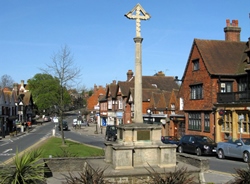 As geologist and science writer Nina Morgan discovers some of the most moving war memories are set in stone
As geologist and science writer Nina Morgan discovers some of the most moving war memories are set in stone
The appearance of war memorials marked one of the many changes to the British landscape brought about by the First World War. Bodies of the fallen were not repatriated, so many bereaved families were denied even the small comfort of a nearby grave on which to focus their grief. Instead, local groups formed committees to create war memorials to commemorate their dead. There are thought to be around 100,000 war memorials in Britain, around two-thirds of them from the First World War.
Local initiatives
In contrast to the war cemeteries established by the (then) Imperial, (now, Commonwealth) War Graves Commission, where the design of the memorials and headstones was strictly regulated (see War Graves Design by Committee got it Right, Geoscientist, 24.10, November 2014), decisions about erecting local war memorials was left to local committees. It was perhaps this outpouring of local grief and unregulated design initiatives that prompted the geologist Archibald Geikie [1835 – 1924] director of the Geological Survey from 1882 – 1901 and then retired and living in Haslemere, Surrey, to write to The Times on 10 June 1919.
In the course of his fieldwork in Scotland, Geikie became interested in gravestones as means of studying weathering in stone, and was appalled at the speed with which certain stone types degraded (see The Wasting of Time, Geoscientist 25.9, October 2015)
In a letter to the Editor, headlined White Marble Unsuitable, Geikie wrote:
"Sir, As so many monuments are about to be erected all over the country in memory of those who have fallen in the war, it may be useful to give a word of advice as to the material that should not be chosen in the construction of them.
"On no account should white statuary marble be employed in any structure in the open air. Even the purest air of the country contains carbonic acid, which, dissolved in falling rain, acts on the stone as a solvent. In our rainy climate only a few years suffice to remove the polish from the surface, which gradually becomes rough and granular, so that one can wipe off the crumbling powder with the hand. In the air of large towns other acids, produced from the burning of coal are added to the atmosphere and increase the solvent action of the rain.
“Many years ago I studied this process of decay among graveyards in towns and in the country and as a the result of my observations I found that in town air a marble monument freely exposed to air, rain, wind, and frost will seldom last as much as a hundred years ... Of course, a cynic may say that in the great majority of cases it will be no great matter if, at the end of a hundred years or less, a marble monument has fallen into ruins ... But our war memorials are meant to outlive generations, it is surely desirable that care should be taken to construct them of the most durable materials that can be obtained."
Circumstantial evidence
The date of the letter, combined with personal connections, all suggest Geikie may have had something to do with the erection of the magnificent Grade II listed war memorial that graces the High Street in Haslemere (picture). The gable-topped cross that tops the memorial was designed by the country house architect, garden designer and author, (Henry Benjamin) Inigo Triggs [1876 – 1923]. Triggs was also the designer of Broad Dene, a wonderful Arts and Crafts house situated near Geikie's own home in Hill Road, Haslemere.
Given his interests, Geikie may well have influenced the choice of stone. But what is the stone? From pictures, only two things are certain. Nearly 100 years after it was erected the Haslemere war memorial is still in excellent condition – and it is not made of marble!
Acknowledgements
I thank Julia Tanner, curator of the Haslemere Educational Museum for making local enquiries about the origin of the Haslemere war memorial on my behalf and passing on the helpful responses. Other sources include: a letter from Archibald Geikie to the Editor of The Times published on 10 June 1919; the websites www.learnaboutwarmemorials.org and www.warmemorialsonline.org.uk; and the Wikipedia and Dictionary of National Biography entries for Inigo Triggs.
* Nina Morgan is a geologist and science writer based near Oxford. Her latest book, The Geology of Oxford Gravestones, is available via www.gravestonegeology.uk